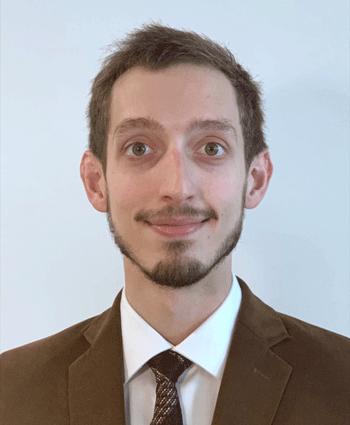Jacob Herrmann, a postdoctoral research fellow at Boston University and University of Iowa alumnus, talks about his research as if he’s speaking about a precious art piece or revered treasure. He’s passionate about the questions he’s trying to decipher, as well as the complexity of the body’s organs.
“The lung is absolutely fascinating,” Herrmann says. “It has this beautiful branching structure of airways and this complex network of sponge-like tissues, and all of it is in motion, so it's a very challenging problem because of all of those complicated mechanical interplays.”

Herrmann followed his mentor, David Kaczka, from Boston to Iowa City to conduct medical ventilation research. Herrmann ended up earning a PhD in biomedical engineering in 2018.
His project included applications of biological tissue mechanics and physiology, fluid mechanics and gas transport, medical imaging, signal processing, numerical optimization, and computational simulation.
“My doctoral research was directed toward optimizing mechanical ventilation—this is a necessary life support intervention.” Herrmann said. “Patients who can't breathe on their own, who are in respiratory failure, or who are sedated, they can be supported by a mechanical ventilator that provides the gas exchange that they need to live.”
However, for patients who are already vulnerable due to respiratory illness or injury, the ventilator can inadvertently exacerbate injury and contribute to worsening patient condition. Herrmann’s research was focused on ways to treat the injured lungs with the safest possible ventilation.
Herrmann’s work addressed a known healthcare problem and translated basic research in lung mechanics and physiology into a solution for intensive care physicians. Ultimately, this is helping to reduce mortality and improve care for critically ill patients.
Data gathered from Herrmann’s research also led to a National Institutes of Health Small Business Technology Transfer Award and support from the University of Iowa Research Foundation to create a start-up company with Kaczka. At the start-up company, OscillaVent, Inc., Herrmann and Kaczka continue the translational development and pre-clinical trials of a prototype multi-frequency ventilator to advance the standard of care for acute lung injury.
Herrmann’s mentors say without a doubt that his research was one of the most technically challenging doctoral projects they’ve encountered—involving computational modeling of gas transport in the lung, complex physiological experiments, and novel image processing techniques.
To recognize his outstanding doctoral work, Herrmann was given the Rex Montgomery Dissertation Prize by the Graduate College. The accolade recognizes the most meritorious dissertation by a doctoral student conducting research in prevention of disease and/or the translation of research into clinical practice.
When told of the well-deserved accolade, Herrmann was humbled and expressed a deep appreciation for the support he received during his time on campus. “I never thought I’d come to Iowa, but I grew to love it when I was there.” he says.
Back on the east coast, Herrmann is still working on lung mechanics, but his focus has shifted.
“I’ve moved toward studying the diseases of emphysema and fibrosis,” Herrmann says. “And this is now getting much more into the microscale level of how the cells and the environment that they're in interact with each other, under dynamic mechanical stresses and strains. Our goal is to identify the biophysical mechanisms that drive disease progression, and that may reveal targets for therapeutic interventions.”
Herrmann says that he loves both research and teaching. He sees himself taking a tenure track faculty position in the future. He also shared a few words of wisdom with current graduate students.
“Look for opportunities to build collaborations. The University of Iowa is an extremely friendly and collaborative environment. It's not something you find everywhere you go.” Herrmann says. “There is no way I could have done this on my own. I’m grateful to many people from different labs and departments that contributed their skills, knowledge, and time to make this project possible.”